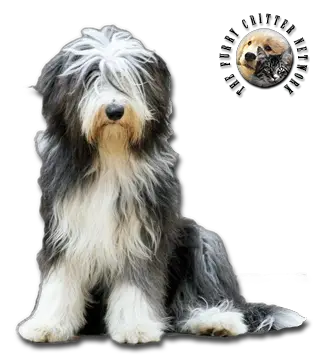Breed Standard
Head: Wide and flat. Strong muzzle. Moderate stop. Large, squarish nose.
Ears: Medium size, hanging close to the head.
Eyes: Large and wide-set. Color varies according to coat color. Eyebrows arched to the sides, framing the head.
Body: Long. Deep chest. Ribs well sprung. Strong loin. Straight back. Underline fairly high off the ground.
Tail: Set low and covered with abundant hair. Not kinked or twisted. Carried low and curving up slightly at the tip.
Hair: Long, flat, harsh, b, and shaggy. Sometimes wavy. Coat increases in length at the cheeks and chin, forming the characteristic beard.
Coat: Slate, dark fawn, black, blue, any shade of gray, with or without white markings. Coat does not take on its definitive color until the age of three, lightening and darkening several times over the first three years.
Size: Dog: 53 to 56 cm.Bitch: 51 to 53 cm.
Weight: 20 to 30 kg.
History
The Bearded Collie, affectionately called the Beardie, was developed in Scotland as a herding dog. Its ancestors likely included herding dogs from the European continent, such as the Poland Lowland Sheepdog (Polski Owzcarek Nizinny) and the Komondor, blended with the sheep herding dogs of the British Isles. It was developed as an independent worker, able to make decisions concerning the welfare and safety of its charges without depending on the shepherd, who might be miles away. The Beardie is still used as a shepherd’s helpmate — not only in its native Scotland, but all over the world.
Behavior
Bearded Collies make excellent pets for those willing to accommodate their high energy level, they are very enthusiastic and have a bouncy nature. They also require regular grooming; weekly brushing is mandatory for keeping their long hair mat-free. Some Bearded Collie owners opt to keep their pets in a "puppy cut" haircut, which reduces the need for brushing. Bearded Collies are an energetic breed, originally intended to work in the Scottish Highlands herding sheep; they also excel at treibball, dog agility and obedience trials. A loyal and family-friendly dog, the Beardie can add years of pet-ownership enjoyment to the home. They have keen problem-solving abilities, and are entertaining to watch.
In training, beardies can be independent, they will go from A to B but maybe not via the expected route. One of the most common problems for new Beardie owners is the breed's intelligence makes them prone to get quickly fed up if training gets too repetitive.
This well-balanced, lively dog is neither shy nor aggressive. He is self-confident, affectionate, and always ready to play. The Bearded Collie, which becomes very attached to his owner and adores children, does not like to be left alone. Though he barks a lot, he does not make a very good guard dog. His good sense of smell is put to use searching for truffles. Early, firm (though not harsh) training is required.
Function
The Bearded Collie may have earned its nickname "bouncing Beardie" because the dogs would work in thick underbrush on hillsides; they would bounce to catch sight of the sheep. Beardies also have a characteristic way of facing a stubborn ewe, barking and bouncing on the forelegs. Whatever the reason, a typical Bearded Collie is an enthusiastic herding dog which requires structure and care; it moves stock with body, bark and bounce as required. Very few Beardies show "eye" when working; most are upright.
Herding instincts and tractability can be assessed in noncompetitive herding tests. Beardies exhibiting basic herding instincts can be trained to compete in herding trials., Pet.
Health
Bearded Collie owners in the UK reported that the most common health issues among living dogs were musculoskeletal—mostly arthritis and cruciate ligament rupture (CLR)—gastrointestinal (primarily colitis and diarrhea) and urologic diseases. Beardie owners in the US and Canada reported that the most common health problems were hypothyroidism, cancer, hypoadrenocorticism (also known as Addison's disease), arthritis and skin problems. Morbidity in the two studies is not easily compared, however; the UK report grouped diseases, while the USA/Canada report ranked more specific conditions.
Further existing breed dispositions of the Bearded Collie include: Dermatological conditions, such as pemphigus foliaceous and black skin disease, follicular dysplasia, musculoskeletal conditions such as congenital elbow luxation, ocular conditions, such as corneal dystrophy, cataract and generalized progressive retinal atrophy (GPRA).






